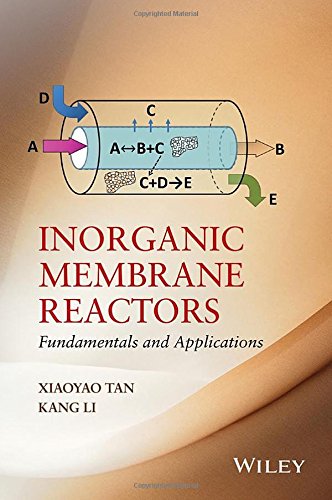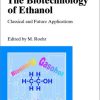(Ebook PDF)Inorganic Membrane Reactors Fundamentals and Applications 1st Edition by Xiaoyao Tan, Kang Li ISBN 9781118672846 1118672844 full chapters
$50.00 Original price was: $50.00.$35.00Current price is: $35.00.
(Ebook PDF)Inorganic Membrane Reactors Fundamentals and Applications 1st Edition by Xiaoyao Tan, Kang Li-Ebook PDF Instant Download/Delivery:9781118672846, 1118672844
Instant download Full Chapter of Inorganic Membrane Reactors Fundamentals and Applications 1st Edition after payment

Product details:
ISBN 10:1118672844
ISBN 13:9781118672846
Author: Xiaoyao Tan, Kang Li
Membrane reactors combine membrane functions such as separation, reactant distribution, and catalyst support with chemical reactions in a single unit. The benefits of this approach include enhanced conversion, increased yield, and selectivity, as well as a more compact and cost-effect design of reactor system. Hence, membrane reactors are an effective route toward chemical process intensification.
This book covers all types of porous membrane reactors, including ceramic, silica, carbon, zeolite, and dense metallic reactors such as Pd or Pd-alloy, oxygen ion-conducting, and proton-conducting ceramics. For each type of membrane reactor, the membrane transport principles, membrane fabrication, configuration and operation of membrane reactors, and their current and potential applications are described comprehensively. A summary of the critical issues and hurdles for each membrane reaction process is also provided, with the aim of encouraging successful commercial applications.
The audience for Inorganic Membrane Reactors includes advanced students, industrial and academic researchers, and engineers with an interest in membrane reactors.
Table of Contents:
1 Fundamentals of Membrane Reactors
1.1 Introduction
1.2 Membrane and Membrane Separation
1.2.1 Membrane Structure
1.2.2 Membrane Separation
1.2.3 Membrane Performance
1.3 Inorganic Membranes
1.3.1 Types of Inorganic Membranes
1.3.2 Fabrication of Inorganic Membranes
1.3.3 Characterization of Inorganic Membranes
1.3.4 Applications of Inorganic Membranes
1.4 Inorganic Membrane Reactors
1.4.1 Basic Principles of Membrane Reactors
1.4.2 Incorporation of Catalyst in Membrane Reactors
1.4.3 Configuration of Membrane Reactors
1.4.4 Classification of Membrane Reactors
References
2 Porous Membrane Reactors
2.1 Introduction
2.2 Gas Permeation in Porous Membranes
2.2.1 Types of Porous Membranes
2.2.2 Transport Mechanisms
2.2.3 Gas Permeation Flux through Porous Membranes
2.3 Preparation of Porous Membranes
2.3.1 Dip-Coating Method
2.3.2 Sol-Gel Method
2.3.3 Chemical Vapor Deposition Method
2.3.4 Phase Inversion Method
2.3.5 O ther Preparation Methods
2.4 Porous Membranes for Chemical Reactions
2.4.1 Membrane Materials
2.4.2 Membrane Functions
2.5 Catalysis in Porous Membrane Reactors
2.5.1 Catalyst in Membrane Reactors
2.5.2 Catalyst Deposition in Porous Membranes
2.6 O peration of Porous Membrane Reactors
2.6.1 Packed Bed Membrane Reactors
2.6.2 Catalytic Membrane Reactors
2.6.3 Coupling of Membrane Functions
2.6.4 Non-uniform Distribution of Membrane Permeability
2.7 Applications of Porous Membrane Reactors
2.7.1 Dehydrogenation Reactions
2.7.2 Reforming Reactions for Hydrogen Production
2.7.3 Partial Oxidation Reactions
2.7.4 Gas–Liquid–Solid Multiphase Reactions
2.7.5 O ther Reactions
2.8 Prospects and Challenges
Notation
References
3 Zeolite Membrane Reactors
3.1 Introduction
3.2 Permeation in Zeolite Membranes
3.2.1 Types of Zeolite Membranes
3.2.2 Transport Mechanisms
3.2.3 Permeation Flux in Zeolite Membranes
3.3 Preparation of Zeolite Membranes
3.3.1 In-Situ Crystallization Method
3.3.2 Secondary Growth Method
3.3.3 Vapor-Phase Transport Method
3.3.4 Microwave Synthesis Method
3.4 Configuration of Zeolite Membrane Reactors
3.4.1 Packed Bed Membrane Reactor
3.4.2 Catalytic Membrane Reactor
3.4.3 Pervaporation Membrane Reactor
3.4.4 Membrane Microreactor
3.5 Applications of Zeolite Membrane Reactors
3.5.1 Dehydrogenation Reactions
3.5.2 Dehydration Reactions
3.5.3 Oxidative Reactions
3.5.4 Isomerization Reactions
3.6 Prospects and Challenges
Notation
References
4 Dense Metallic Membrane Reactors
4.1 Introduction
4.2 Gas Permeation in Dense Metallic Membranes
4.2.1 Types of Dense Metallic Membranes
4.2.2 Hydrogen Permeation Mechanism in Pd-Based Membranes
4.2.3 Effect of Substrate on H2 Permeation
4.3 Preparation of Dense Metallic Membranes
4.3.1 Cold-Rolling and Diffusion Welding Method
4.3.2 Electroless Plating Method
4.3.3 Electroplating Method
4.3.4 Chemical Vapor Deposition Method
4.3.5 High-Velocity Oxy-Fuel Spraying Method
4.3.6 Magnetron Sputtering Method
4.3.7 Summary
4.4 Configurations of Metallic Membrane Reactors
4.4.1 Packed Bed Membrane Reactor
4.4.2 Membrane Microreactor
4.5 Applications of Dense Metallic Membrane Reactors
4.5.1 Dehydrogenation Reactions
4.5.2 Reforming Reactions for H2 Production
4.5.3 Direct Hydroxylation of Aromatic Compounds
4.5.4 Direct Synthesis of Hydrogen Peroxide
4.6 Challenges and Prospects
Notation
References
5 Dense Ceramic Oxygen-Permeable Membrane Reactors
5.1 Introduction
5.2 Oxygen Permeation in Dense Ceramic Membranes
5.2.1 Membrane Materials
5.2.2 O xygen Permeation Flux in MIEC Membranes
5.3 Preparation of Dense Ceramic Membranes
5.3.1 Isostatic Pressing
5.3.2 Extrusion
5.3.3 Phase Inversion
5.3.4 Slurry Coating
5.3.5 Tape Casting
5.4 Dense Ceramic Membrane Reactors
5.4.1 Principles of Dense Ceramic Membrane Reactors
5.4.2 Configurations of Dense Ceramic Membrane Reactors
5.5 Applications of Dense Ceramic Oxygen Permeable Membrane Reactors
5.5.1 Partial Oxidation of Methane to Syngas
5.5.2 Oxidative Coupling of Methane
5.5.3 Oxidative Dehydrogenation of Alkanes (Ethane and Propane)
5.5.4 Decomposition of H2O, NO x, and CO2
5.6 Prospects and Challenges
Notation
References
6 Proton-Conducting Ceramic Membrane Reactors
6.1 Introduction
6.2 Proton/Hydrogen Permeation in
Proton-Conducting Ceramic Membranes
6.2.1 Proton-Conducting Ceramics
6.2.2 Hydrogen/Proton Permeation in Mixed Conducting Membranes
6.3 Preparation of Proton-Conducting Ceramic Membranes
6.3.1 Suspension Coating
6.4 Configuration of Proton-Conducting Membrane Reactors
6.5 Applications of Proton-Conducting Ceramic Membrane Reactors
6.5.1 Dehydrogenation Coupling of Methane
6.5.2 Dehydrogenation of Alkanes into Alkenes
6.5.3 WGS Reaction and Water Electrolysis for Hydrogen Production
6.5.4 Decomposition of NOx
6.5.5 Synthesis of Ammonia
6.5.6 Challenges and Future Work
Notation
References
7 Fluidized Bed Membrane Reactors
7.1 Introduction
7.2 Configurations and Construction of FBMRs
7.3 Applications
7.3.1 Methane Steam Reforming and Dehydrogenation Reactions
7.3.2 Partial Oxidation Reactions
7.4 Prospects and Challenges
References
8 Membrane Microreactors
8.1 Introduction
8.2 Configurations and Fabrication of Membrane Microreactors
8.2.1 Plate-Type Membrane Microreactors
8.2.2 Tubular Membrane Microreactors
8.3 Applications of Membrane Microreactors
8.3.1 Pd-MMRs for Hydrogenation/Dehydrogenation Reactions
8.3.2 Zeolite-MMRs for Knoevenagel Condensation and Selective Oxidation Reactions
8.3.3 Catalytic MMRs for G–L–S Reactions
8.4 Fluid Flow in Membrane Microreactors
8.5 Prospects and Challenges
References
9 Design of Membrane Reactors
9.1 Introduction
9.2 Design Equations for Membrane Reactors
9.2.1 Packed Bed Membrane Reactors
9.3 Flow-Through Catalytic Membrane Reactors
9.3.1 Fluidized Bed Membrane Reactors
9.4 Modeling Applications
9.4.1 Oxidative Dehydrogenation of n-Butane in a Porous Membrane Reactor
9.4.2 Coupled Dehydrogenation and Hydrogenation Reactions in a Pd/Ag Membrane Reactor
9.4.3 POM in a Dense Ceramic Oxygen-Permeable Membrane Reactor
9.5 Concluding Remarks
People also search:
inorganic process minerals
inorganic phosphate molecule
inorganic reaction mechanisms
inorganic nuclear chemistry
inorganic processes
Tags:
Inorganic Membrane Reactors,Fundamentals,Applications,Xiaoyao Tan,Kang Li


